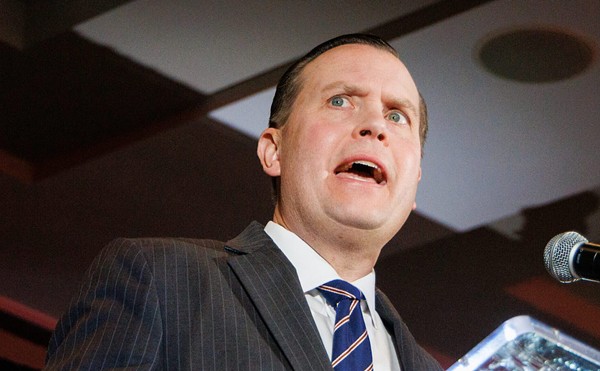C
rime victims, homeless youth, the long-term unemployed and casualties of domestic violence are receiving considerably less resources from Cincinnati’s government than they did in 2004, the last time the city administration and City Council met their goals for human services funding.
The money going to human services is traditionally linked to the city’s adult homeless, but the money also flows to a swathe of different local agencies and programs. Some examples: Lighthouse Youth Service’s efforts to reach out to homeless children, Talbert House’s crime victims program, the Urban League’s job training offerings and Women Helping Women’s interventions for victims of domestic abuse.
Year after year, city officials have put the agencies and their programs on the chopping block. Even though human services funding has never represented more than 1.5 percent of the operating budget, it’s been cut by roughly 66 percent since 2004.
For the city, the cuts represent a broken promise. City budgets used to proudly tout a goal to direct 1.5 percent of spending to human services, but that vow has practically vanished from recent budget proposals.
Despite the city already falling short of its goal, this year’s budget initially eliminated more than one-third of human services funding. City Council is now undoing the cuts with higher-than-projected revenues from the previous budget cycle, but for many human services agencies the initial cuts raised questions about the city’s priorities.
The restorations, which were approved two months after Council passed the budget containing cuts, also don’t solve the long-term problem, especially as Cincinnati braces for more budget shortfalls in the next few years.
When asked about the funding reductions, the city administration typically points to citizen surveys and meetings conducted as part of the priority-driven budgeting process in 2012. During that process, local respondents ranked human services funding in the bottom 25 percent of city programs.
But a CityBeat analysis found low- and no-income Cincinnatians, who benefit the most from human services funding, were underrepresented by roughly half in both the mail-in surveys and meetings, while the wealthiest Cincinnatians had nearly double the representation they proportionally deserved.
Advocates of human services have different theories for why their causes consistently face uncertain funding: Some say Council doesn’t care about poor people, who are less likely to vote and otherwise participate in the electoral process. Others sympathize with the complicated task of balancing the city budget. Most feel human services funding is being picked on.
Whatever the reason, the agencies now know what to expect: When budget season arrives, it’s time to prepare for cuts.
Doing less with less
In May, the city’s Human Services Advisory Committee (HSAC) met to discuss the impending cuts to human services. Although the committee’s first recommendation to City Council was to avoid any cuts, its members knew full well that the city’s pressing budget gap would likely lead to more reductions to human services.
The cuts ended up being massive, with the city slashing $510,000, or 34.3 percent of all human services funding. Unwilling to disproportionately hit any single human services agency, HSAC members agreed to recommend across-the-board cuts.
The cuts are now being undone by City Council, which is using leftover revenue from the previous budget year to restore several programs. But the initial cuts were only the latest in a decade-long trend of reduced funding that has left human services agencies with much less funding than they received in 2004.
For Lighthouse Youth Services, city funding doesn’t make up a huge percent of the agency’s overall budget, but the money helps finance street outreach, a youth crisis center and transitional housing for young adults — the programs Geoff Hollenbach leads as head of the Runaway and Homeless Youth Division.
Hollenbach explains how the programs synergize: Through street outreach, the agency finds struggling children and convinces them to get help. Then the youth crisis center houses children between the ages of 10 and 17, while transitional housing helps young adults between 18 and 24 prepare to live and stand on their own.
The street outreach process is particularly important, Hollenbach says. For many homeless people, accepting help may seem like a daunting, even frightening, prospect, and street outreach is meant to allay such concerns.
“We know that people who are experiencing homelessness don’t know the system and they don’t know what’s going to happen to them once they get in the system,” he says. “The role of street outreach is to really engage these youth, gain their trust and let them know that services are out there for them.”
Outreach can also involve the basics, such as providing food and hygiene products. “Our job is really to help them to survive on the streets until they’re ready to make a commitment to come into shelter,” Hollenbach explains.
There are also various barriers that further complicate helping troubled youth: substance abuse, mental health problems and a general distrust toward other people.
Those hurdles would likely go unaddressed without street outreach, which has been steadily weakened by the city’s cuts, according to Hollenbach.
The cuts have also affected services offered in the youth crisis center and transitional housing: food, toiletries, clothing, bedding, transportation and activities. Activities might seem like a luxury, but they provide an outlet for stress and mental health relief that’s crucial for adequate care, Hollenbach says.
“If you get 10 or 15 kids that are in crisis and going through a lot of emotional turmoil, letting them sit around would turn the turmoil into acting out,” he says. “One way to maintain a safe environment is to provide them with daily activities.”
The activities include arts and crafts, outings and lessons from professionals and artisans. Hollenbach says the variation breaks up the children’s days, giving them more opportunities to cope with their feelings of isolation, depression and anxiety.
If the city’s trend of cuts continues, it could also lead to layoffs, which present a major problem for an organization that sees itself as underfunded in the first place. “All of our programs are leanly staffed already,” Hollenbach says.
During several interviews CityBeat conducted with human services providers, that was the common theme: Every provider agreed that human services agencies don’t get enough money to begin with, whether the funding comes from private contributions or public funding.
Neil Tilow, president and CEO of Talbert House, cites his agency’s
aid for crime victims as one example. The program assists people affected by crimes ranging from phone harrasment to sexual assault.
“We got about 3,000 referrals last year from the Cincinnati Police Department, and the total funding from the city is $40,000 or $50,000,” Tilow explains. “There’s no way to serve that many people. It takes more than $10 or $15 a person to serve somebody — to contact them, to send them information, sometimes to counsel them and sometimes to go to court with them.”
He adds, “These are folks who through no fault of their own in our city have been harmed. We want to make sure they get the right support.”
The cuts actually end up being three times as big for the crime victims program, which gets $2 from the state government for every dollar from the city as part of an automatic funding formula. So when the city cuts human services funding to the Talbert House, the program also loses twice that amount from the state. Other agencies lose out on similar funding matches.
If it were up to HSAC, human services agencies wouldn’t have lost funding at all. Every year, the committee recommends City Council leave funding alone. But every year since 2004, the city manager has suggested further cuts — sometimes proposing an outright elimination of human services funding — and occasionally City Council agrees.
In a way, the back-and-forth goes against the initial goals of HSAC. The committee is a citizen advisory group that’s supposed to help shape the city’s policy for human services. But in the past decade, it’s been forced to carry out cuts of which it disapproves.
HSAC does its duties under some guidelines. Funding can only go to four categories of programs dictated by the city: housing, emergency assistance to individuals in crisis, violence prevention and job training and search services.
The process is also competitive. HSAC members are broken up into different areas of human services and review which programs are the best in each field. The most promising are awarded varying degrees of funding depending on their size and scope.
Although Council is now restoring this year’s cuts, the agencies still feel they’ve been unfairly targeted. To make matters worse, the city administration’s explanation for the cuts offers little comfort to local providers.
Ignoring the poor
Cincinnati has faced financially tumultuous times in the past decade. City revenues in particular have plummeted thanks to a decreasing population, cuts in state funding and the aftermath of the Great Recession.
Advocates of human services acknowledge the difficulties. They understand cuts have to be made somewhere. Hollenbach admits, “I can’t even imagine what it’s like to put a city budget together.”
But what Hollenbach, Tilow and other providers don’t understand is why human services funding is disproportionately targeted every year.
Take the budget proposals from this year: The city had a budget gap of about $35 million, or about 10 percent of the budget. Yet in his original “Plan B,” City Manager Milton Dohoney suggested eliminating all human services funding.
The city manager eventually brought down his proposed cuts to roughly one-third of human services funding, but that was still disproportionate to the overall budget gap.
City Council is now undoing those cuts altogether, but the restorations don’t reverse the long-term trend. The city has historically aimed to direct 1.5 percent of the operating budget to human services, but the last time the city upheld the goal was the 2004 budget.
Back then, human services funding was $4.7 million. Funding is now at $1.6 million. That’s a roughly 66-percent cut at a time when the budget has actually grown by 10 percent.
Even with Council’s latest restorations, human services funding is at 0.4 percent of the operating budget, roughly a quarter of the city’s 1.5-percent goal.
When asked why the city has carried out such cuts, city spokesperson Meg Olberding responded in an email, “It was ranked in the lowest quartile as we went through the public process called priority based budgeting.”
For the priority-driven budgeting process, the city hired the the Center for Priority-Based Budgeting and Novak Consulting Group and conducted various kinds of surveys and meetings to gauge public opinion about what programs the city should prioritize in its budget. Human services funding ended up ranking in the bottom 25 percent.
But there’s clear evidence the process was skewed in favor of the wealthiest Cincinnatians and against low-income people, who benefit the most from human services funding.
Only 22 percent of respondents to the mailed questionnaires made less than $25,000, even though 40.8 percent of Cincinnati’s overall population makes that little. About 10 percent of respondents made $150,000 or more, compared to the 6 percent of the population at large that makes that much.
Surveys conducted during meetings were just as unrepresentative. About 22 percent of attendees made $23,050 or less a year, and about 11 percent made $150,000 or more. “While this is not representative of the population at large, the data does indicate strong participation from low income residents,” the meeting documents stated.
The electronic survey had the worst demographic disparities: Six percent of respondents made $23,050 or less a year, and 16.3 percent made $150,000 or more.
The city administration has yet to answer questions as to why it still relies on the priority-driven budgeting process, particularly for cutting programs that largely impact an underrepresented group.
Vice Mayor Roxanne Qualls acknowledges City Council used the surveys as one source of input. But she cautions, “Ultimately, it’s up to the policymaker to balance that against other information and also other needs.”
One program for which Council dismissed the results was the city’s SWAT team, which was poorly ranked in the priority-driven budgeting process but received funding anyway.
Qualls says Council would have liked to tone down the city manager’s recommended cuts for human services before the budget was passed, but members decided to wait to see how much revenue was left over from the previous budget cycle.
On July 25, Qualls announced that the city intends to use higher-than-projected revenues to undo this year’s $510,000 in cuts to human services funding. The announcement was followed up with an official motion on July 30.
Qualls, who’s running for mayor against John Cranley, Jim Berns and Sandra “Queen” Noble, made the announcement at a mayoral forum hosted by the Human Services Chamber of Hamilton County, a newly formed organization of local social service groups that seeks to shine light on human services issues around the region.
Tilow, whose agency is part of the Human Services Chamber, says Qualls’ announcement was a big victory for the organization, but the goal is to get human services funding restored back to 1.5 percent. As he sees it, more funding just makes financial sense for the city.
“If we get somebody to get stable and get back to work, they start paying taxes and they stop being on public assistance,” he says. “They start being a plus to the community instead of a burden in some way.”
Mary Rivers, a member of HSAC, says there’s an economic case for a stronger social safety net through human services funding.
In 2011, a country-by-country analysis from the International Monetary Fund (IMF) concluded, “We find that longer growth spells are robustly associated with more equality in the income distribution. For example, closing, say, half the inequality gap between Latin America and emerging Asia would, according to our central estimates, more than double the expected duration of a growth spell.”
At the same time, the most equal developed countries of the world, such as Sweden and Denmark, have some of the strongest social safety nets and redistributive policies.
Meanwhile, Cincinnati faces two major economic problems: A 2011 study from the National Center for Children in Poverty found about 48 percent of the city’s children are in poverty. Another study released this month by economists at Harvard University and University of California, Berkeley, found Cincinnati ranked 650 among 728 markets analyzed for upward economic mobility.
Given these problems and the IMF’s research, Rivers says Cincinnati should be working to prioritize human services funding.
Two worlds
Although the city will avoid cuts to human services for the upcoming year, the future might remain bleak for the agencies. In the next few years, the city is projecting more budget gaps as a consequence of failing to structurally balance its budget since 2001.
The budget issues stand in contrast to Cincinnati’s strong economic momentum, which has consistently trumped national averages in the past few years as people have flocked to live, work and play downtown in what’s being called a revitalization.
Given the city’s financial woes and the focus on positive developments, many providers are concerned that prevailing public attitudes — perhaps accentuated by the priority-driven budgeting process — might give city officials the political cover needed to overlook and undervalue human services.
But with the new Human Services Chamber of Hamilton County in tow, advocates are prepared to reverse the defunding trend. They’ve seen the pain caused by cuts in the past decade, and they’re unwilling to let the city do away with what they see as a moral obligation.
“Many of our clients need a hand up and will do much better in life with a little support, just as you had and I had from somebody in our life, whether it was a parent, relative or teacher,” Tilow says, invoking his work at Talbert House. “Many of our clients haven’t had that same privilege that we had.” ©





